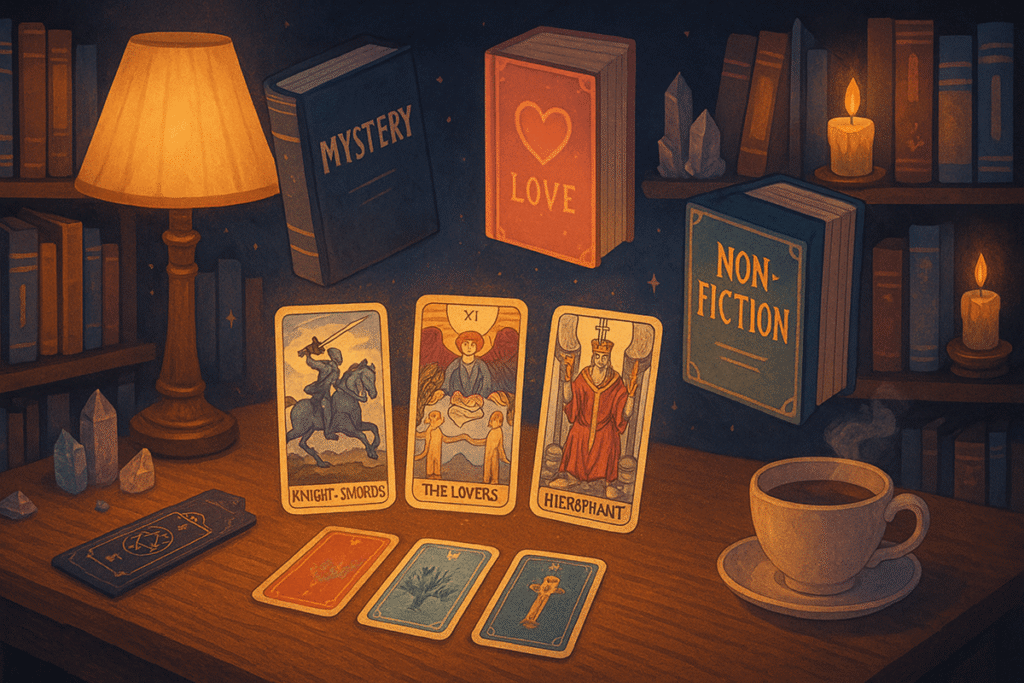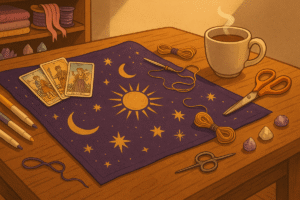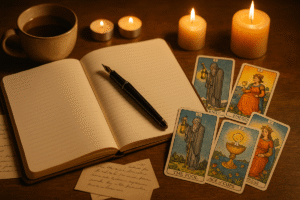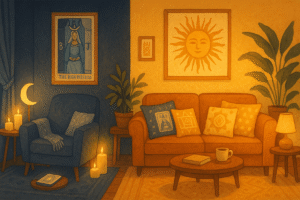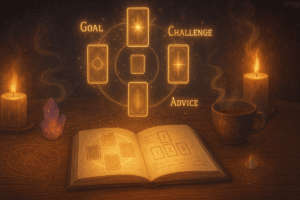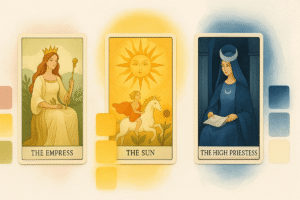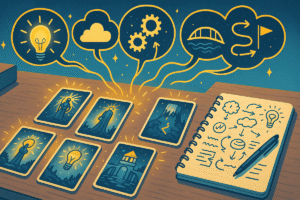Table of Contents
There’s something quietly magical about standing in front of a bookshelf, overwhelmed by choices, wondering which story deserves your time next. I think most readers have felt that particular paralysis, where every book seems equally appealing and simultaneously uncertain. What if there was a way to turn that decision into something more playful, more intuitive? Using tarot cards as a creative prompt for book selection offers exactly that.
This isn’t about fortune telling or predicting which book will change your life. Rather, it’s a reflective practice that helps you tune into your current mood, interests, and reading needs. The cards become mirrors, reflecting back themes and energies that might resonate with what you’re seeking right now. Perhaps you’re craving adventure without realizing it, or maybe you need something contemplative. The cards can help surface those unspoken preferences.
Why Use Tarot for Book Selection
The connection between tarot and storytelling runs deeper than you might initially think. Each card in a tarot deck tells its own story, filled with archetypal characters, symbolic journeys, and emotional landscapes. These same elements form the foundation of compelling literature. When you draw a card and consider its themes, you’re essentially asking yourself what kind of narrative energy you’re drawn to in this moment.
I’ve found this method surprisingly effective, though I should admit it took a few tries to feel natural. At first, it seemed almost too whimsical. But there’s something valuable in removing the pressure of making the “right” choice. Books are meant to be enjoyed, and sometimes we overthink the selection process. Using tarot cards introduces an element of play and spontaneity that can actually make the whole experience more enjoyable.
The practice also encourages you to think about books thematically rather than just by genre labels or bestseller lists. You might discover connections between seemingly different types of books, or realize that what you thought you wanted to read isn’t actually calling to you right now. It’s a tool for self reflection, really, disguised as a decision making game.
Setting Up Your Tarot Book Selection Practice
You don’t need an elaborate ritual or special setup for this. A simple tarot deck and your reading list (or bookshelf access) will do perfectly fine. Some people like to keep a reading journal nearby to note which cards led them to which books, creating a personal reference over time. That’s entirely optional, though it can be interesting to look back and see patterns.
Before you draw a card, take a moment to consider what you’re bringing to this practice. Are you looking for escape, education, comfort, or challenge? You don’t need a definite answer, but a brief check in with yourself helps the card’s message feel more relevant. Think of it as setting a gentle intention rather than making demands.
When you’re ready, shuffle your deck in whatever way feels comfortable. There’s no wrong method here. Draw a single card and place it face up where you can see it clearly. Spend a moment just looking at it before jumping to interpretations. Notice what elements stand out to you first. Sometimes your immediate, intuitive response is more useful than any textbook meaning.
Matching Cards to Book Themes
This is where the practice becomes genuinely creative. There’s no strict rulebook, which means you have freedom to interpret the cards in ways that make sense for your personal reading preferences. That said, certain cards do tend to suggest particular themes and genres quite naturally.
The Knight of Swords, for instance, practically begs for a fast paced thriller. This card embodies swift action, intellectual pursuit, and sometimes reckless forward momentum. It’s the energy of detective novels, political intrigue, or any story where the pace never lets up. When this card appears, I usually find myself gravitating toward books that keep me turning pages late into the night, unable to stop.
The Lovers card, naturally enough, points toward romance. But perhaps more broadly, it suggests books exploring relationships, choices between two paths, and the complexities of human connection. This could mean a classic love story, but it might also lead you to literary fiction examining family bonds or friendship. The card invites you to think about what kind of connection you want to explore through your reading.
The Hierophant brings a more scholarly energy. This card represents tradition, established knowledge, and structured learning. It’s perfect for non fiction, particularly history, philosophy, or religious studies. When I draw this card, I often end up with a book that teaches me something, that challenges me to think differently about established systems or cultural traditions.
The Tower might seem ominous, but for book selection, it’s actually quite exciting. This card represents upheaval, sudden change, and breakthrough moments. It suggests books with dramatic plot twists, stories about revolution or transformation, or memoirs about overcoming crisis. Any narrative built around a world shattering event fits beautifully with Tower energy.
The Moon card carries mystery and intuition. It’s ideal when you’re in the mood for something atmospheric, perhaps a gothic novel, magical realism, or psychological suspense. Books that blur reality and dream, that leave you questioning what’s true, align with this card’s nebulous energy. I think The Moon also works well for poetry collections, where meaning often lives in shadows and suggestions rather than clear statements.
Expanding Your Interpretations
Once you get comfortable with basic card meanings, you can develop more nuanced connections. The Empress might lead you toward lush, sensory writing, books celebrating nature or creativity. The Emperor could suggest epic fantasy with complex political systems, or business books about strategy and structure. The Hermit invites contemplative reads, quiet character studies, or philosophical essays.
Court cards offer interesting possibilities too. Pages often represent learning and curiosity, making them great for coming of age stories or educational books. Queens bring emotional depth and mastery, suggesting character driven fiction or memoirs by accomplished individuals. Kings represent achievement and authority, pointing toward biographies of leaders or sweeping historical sagas.
The suit of the card matters as well. Wands carry creative, passionate energy, suggesting adventure stories or books about art and innovation. Cups deal with emotions and relationships, perfect for anything exploring the human heart. Swords represent intellect and conflict, ideal for mysteries, debates, or sharp social commentary. Pentacles ground us in the material world, suggesting realistic fiction, nature writing, or practical non fiction.
Making It Personal
The real value in this practice emerges when you start developing your own associations. Maybe The Star always makes you think of science fiction, or The Devil reminds you of dark comedy. Your personal connection to the cards will deepen your book selection process in ways no guide can predict.
Keep in mind that you can draw multiple cards for more complex selection needs. Pull three cards for a reading trio representing beginning, middle, and end energies. Use a card for genre and another for mood. There’s no limit to how you can adapt this practice to suit your needs.
Some readers like to draw a card weekly and commit to choosing their next book based on that guidance. Others use it only when they’re truly stuck. Both approaches work fine. The key is treating it as a creative tool rather than a rigid system. If a card suggests something that doesn’t appeal at all, you’re free to draw another or interpret it differently. This should add joy to your reading life, not restriction.
What This Practice Actually Offers
Beyond helping you select books, this method encourages a more reflective relationship with your reading habits. You might notice that you keep drawing Cups cards, suggesting you’re craving emotional depth. Or perhaps Swords dominate, indicating a need for intellectual stimulation. These patterns can reveal something about your current life phase and what you’re unconsciously seeking.
The practice also helps break reading ruts. When you let the cards guide you, you might end up with genres you wouldn’t normally consider. That unexpected recommendation could introduce you to a new favorite author or expand your reading horizons in surprising ways. I’ve discovered several beloved books through this method that I would have otherwise overlooked.
There’s something freeing about making decisions this way. It removes the anxiety of choice and replaces it with curiosity. What will the cards suggest today? How will I interpret this symbol? Where might this energy lead me? These questions transform book selection from a task into an engaging practice.
Starting Your Own Practice
If you’re interested in trying this approach, start simple. Draw a single card before your next library visit or online browsing session. Notice what themes or feelings it evokes. Then see if any books seem to echo that energy. Don’t overthink it initially. Let your intuition guide the connections.
Over time, you might want to keep notes about which cards led you to which books, and how those reading experiences felt. Did the pairing work? Did you enjoy the book? Would you interpret that card differently next time? This informal record can deepen your understanding of both tarot symbolism and your own reading preferences.
Remember that this is meant to be enjoyable and creative, not stressful or binding. If the card’s suggestion doesn’t resonate, you’re absolutely free to draw another or disregard the reading entirely. The cards are tools for reflection, not authorities dictating your choices. They work best when approached with a spirit of playfulness and openness.
Whether you’re a longtime tarot enthusiast or someone who just likes trying new things, using cards to select books offers a unique blend of intuition and intention. It turns a mundane decision into a small ritual, a moment of self connection in an otherwise busy day. And really, anything that helps us engage more deeply with the books we read is worth exploring.
Frequently Asked Questions
Do I need to know all the tarot card meanings to use this method?
Not at all. This practice works beautifully whether you’re a tarot expert or complete beginner. You can start with just the basic themes of a few cards that resonate with you, or simply notice your intuitive response to the imagery. Many people find that treating this as a creative game rather than a formal reading actually makes it more enjoyable and less intimidating.
Can I use oracle cards instead of traditional tarot?
Absolutely. Oracle cards work wonderfully for book selection since they often have even more straightforward themes and messages. The principles are exactly the same: draw a card, consider its energy and symbolism, then match that to a book genre or mood. Use whatever deck speaks to you most clearly.
What if the card I draw doesn’t seem to match any book I own or want to read?
This happens sometimes, and it’s completely fine. You can either draw another card, interpret the original card more broadly, or use it as an opportunity to explore a genre you wouldn’t normally consider. Sometimes the most surprising matches lead to the best discoveries. There are no wrong answers here.

